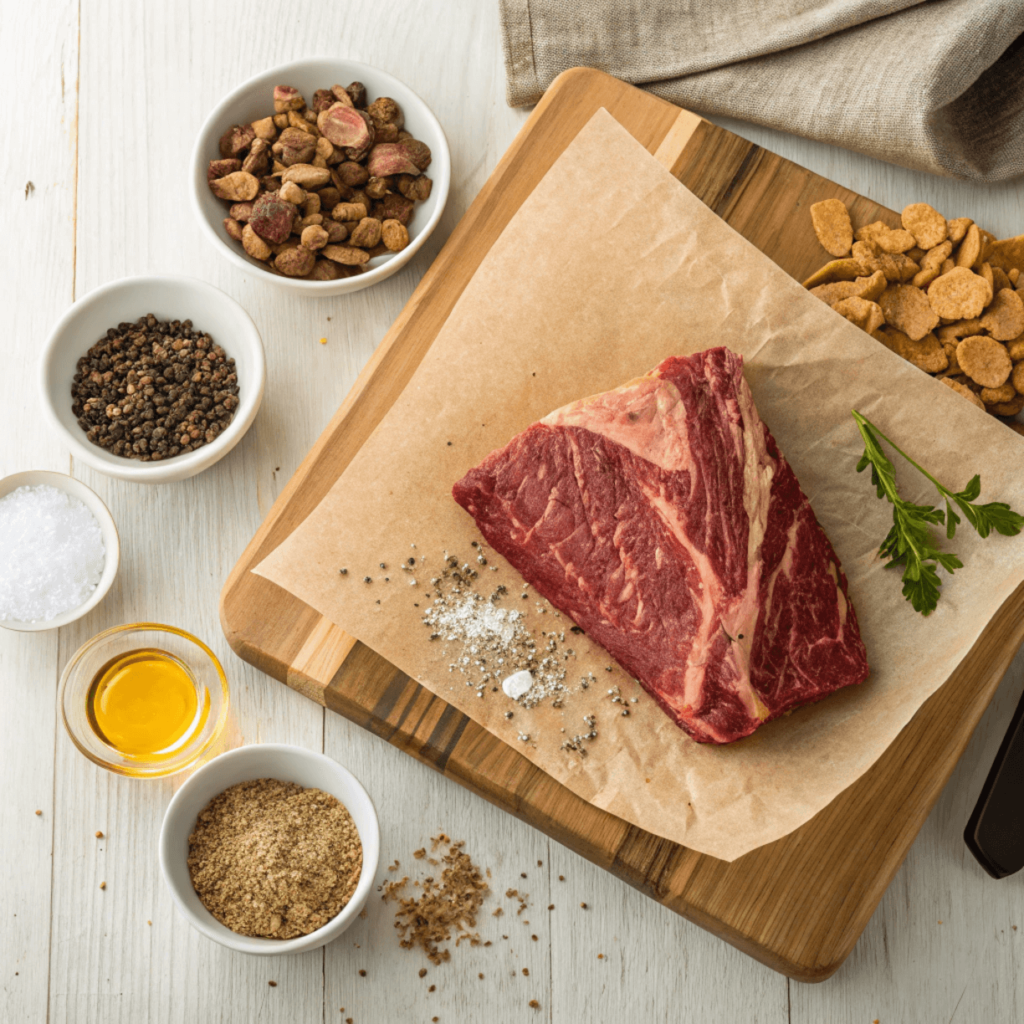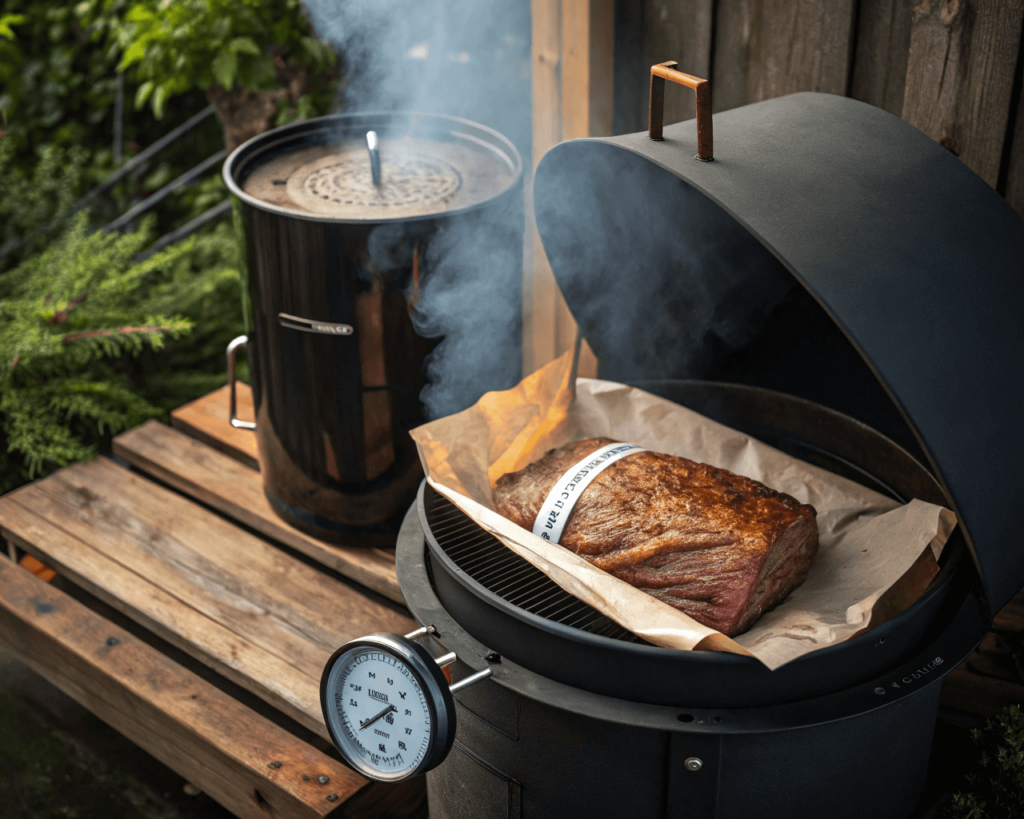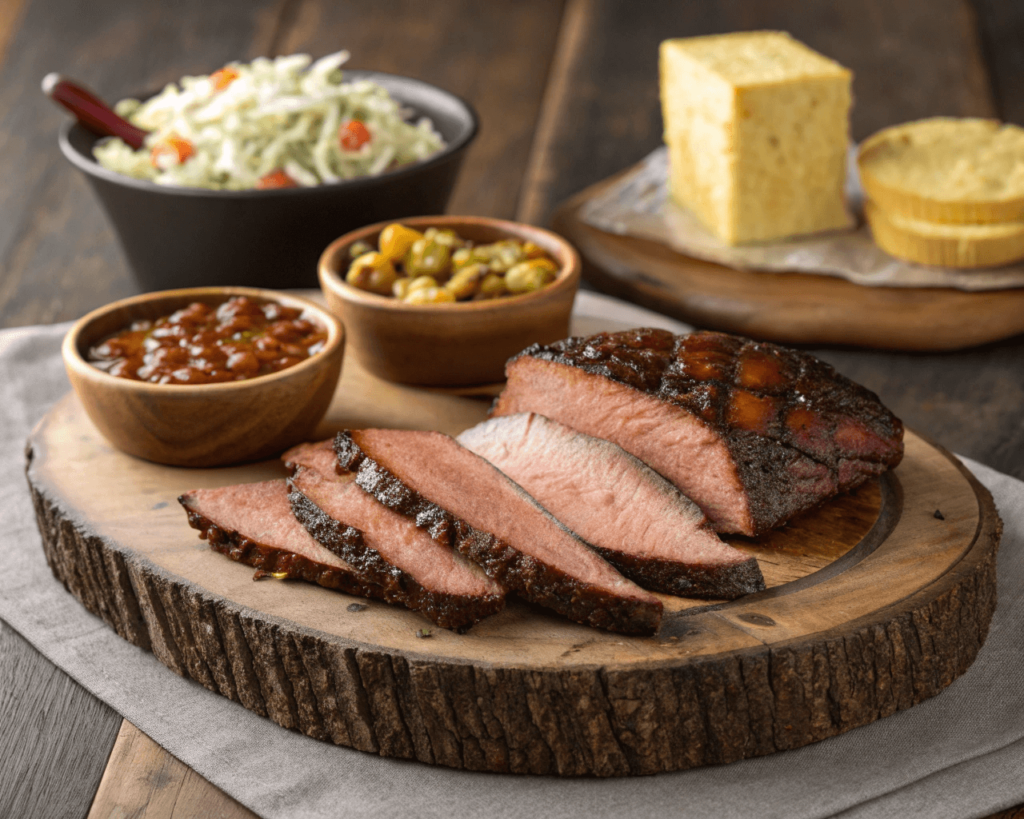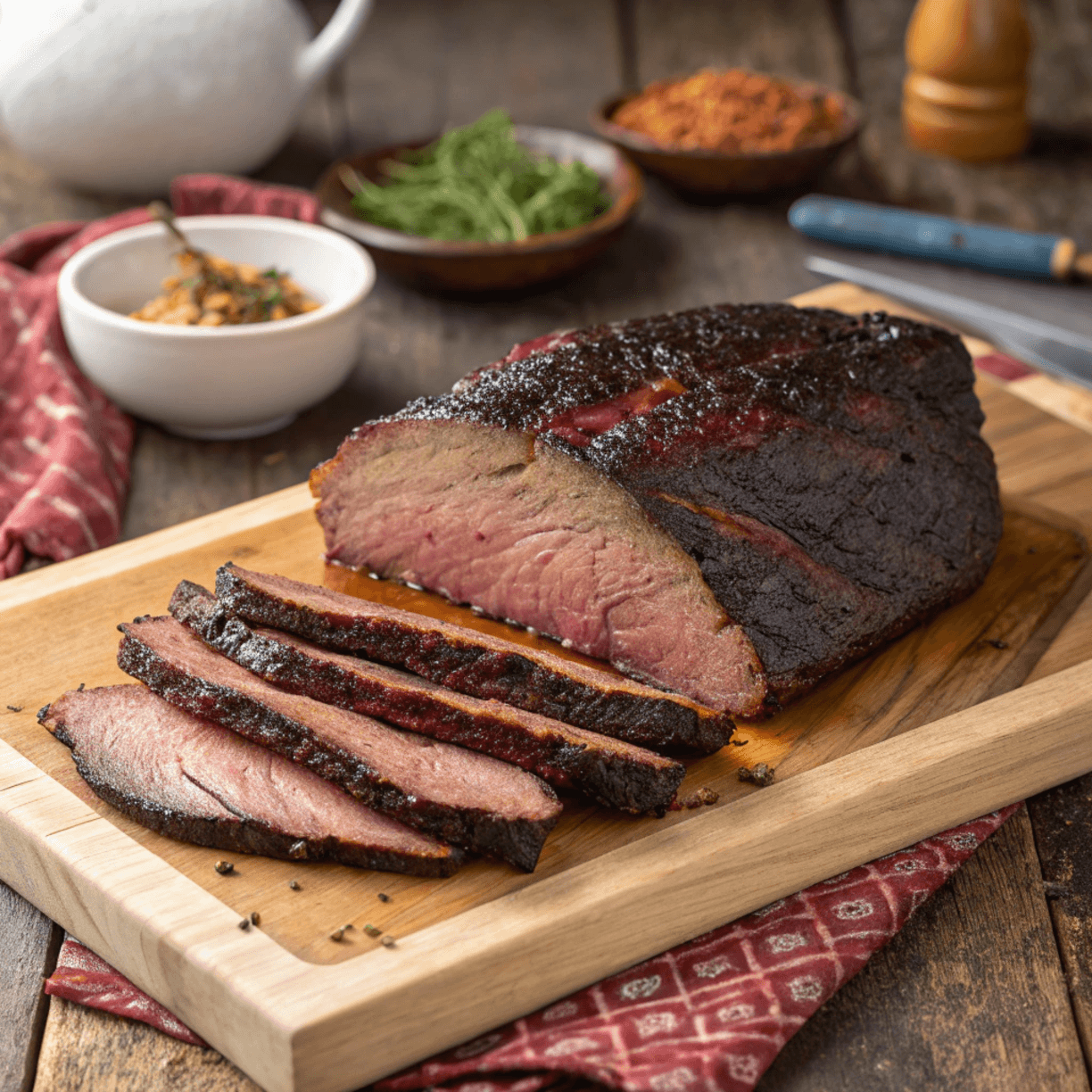Table of Contents
Introduction
If you’re looking for the best smoked brisket recipes, you’ve come to the right place. Mastering the art of smoking brisket can seem intimidating, but with the right techniques, you can create a tender, flavorful masterpiece right in your backyard.
Smoking brisket is more than just a cooking method—it’s a tradition deeply rooted in barbecue culture. Whether you’re aiming for an authentic Texas-style brisket or experimenting with different seasonings, this guide will walk you through everything you need to know. If you’re new to this process, resources like Hey Grill Hey provide great insight into smoking techniques and essential tools.
From selecting the perfect cut of beef to achieving the ideal smoke ring, this step-by-step breakdown will ensure your brisket is packed with flavor and cooked to perfection.
Why You’ll Love This Recipe
Smoking brisket takes patience, but the reward is worth it. Here’s why this recipe will become a staple in your BBQ repertoire:
- Unmatched Flavor: The combination of hardwood smoke, seasoning, and slow cooking creates a deep, rich taste that no other method can replicate.
- Tender and Juicy: A well-smoked brisket is fall-apart tender with the perfect bark (that flavorful, crispy crust).
- Great for Gatherings: Whether it’s a summer cookout or a holiday feast, a smoked brisket is a crowd-pleaser that serves a large group.
- Beginner-Friendly Techniques: With the right guidance, even first-timers can achieve competition-level results.
Want to know more about smoking meat like a pro? Check out these tips from BBQ experts to refine your skills.

Ingredients for the Perfect Smoked Brisket
Main Ingredients
- Brisket: Choose a whole packer brisket (12-14 lbs) with a good balance of fat and marbling.
- Salt & Pepper: A simple kosher salt and coarse black pepper rub enhances the natural beef flavor.
- Garlic Powder (Optional): Adds a subtle depth to the seasoning.
- Mustard or Olive Oil (Optional): Helps the rub adhere to the meat and adds moisture.
Wood Selection
- Oak: Classic and strong, perfect for Texas-style brisket.
- Hickory: Bold and smoky, great for adding a deep BBQ flavor.
- Cherry or Applewood: Slightly sweet, balances out the smokiness.
Variations to Try
If you want to put a unique spin on your brisket, here are some fun variations:
- Kansas City Style: Add a sweet and spicy rub with brown sugar and paprika.
- Memphis Style: Use a dry rub heavy on chili powder and cayenne for extra heat.
- Marinade vs. Dry Rub: Some pitmasters swear by marinating the brisket overnight, while others prefer the simplicity of a salt and pepper rub.

Smoked Brisket Recipes: The Perfect Step-by-Step Guid
Mastering the Smoking Process
When it comes to smoked brisket recipes, achieving the perfect balance of tenderness and smoky flavor requires patience and precision. Whether you’re a seasoned pitmaster or just getting started, following the correct smoking process is essential.
For those who love slow-cooked meats, learning how to prepare brisket properly will enhance your BBQ game. Before you fire up your smoker, check out these top beef recipes for inspiration on how to use different cuts of meat for delicious results.
Now, let’s break down the smoking process step by step to help you create a mouthwatering brisket.
Preparation: Setting Up for Success
Trimming the Brisket
Proper trimming is essential for all smoked brisket recipes. This ensures even cooking and maximizes flavor:
- Leave about ¼ inch of fat on the fat cap to prevent the brisket from drying out.
- Trim excess fat and silver skin from the lean side to allow seasonings to adhere better.
- Shape the brisket evenly to promote uniform cooking.
Once trimmed, it’s time to season your brisket for the best possible flavor.
Seasoning the Brisket
Seasoning plays a critical role in any smoked brisket recipe. Here’s how to do it right:
- Use a simple Texas-style rub of coarse kosher salt and black pepper.
- Add garlic powder or paprika for a deeper flavor profile.
- Consider a binder like mustard or olive oil to help the rub stick to the meat.
If you’re a fan of bold, smoky flavors, you might also love trying this chipotle honey chicken recipe for another smoky, spicy BBQ dish.
The Smoking Process: Low and Slow is Key
Preparing the Smoker
A prope
: Preparing the Smoker
A properly set up smoker makes a huge difference in your smoked brisket recipes. Follow these steps:
- Preheat your smoker to 225°F for optimal low and slow cooking.
- Choose the right wood: Oak, hickory, and cherry are excellent choices for brisket.
- Ensure a steady flow of thin blue smoke, as thick smoke can make the meat bitter.
Once your smoker is at the right temperature, it’s time to place the brisket inside.
The Smoking Process
Smoking a brisket is all about time and temperature:
- Place the brisket fat-side up on the smoker for even cooking.
- Use a meat thermometer to monitor internal temperature—don’t rely on time alone.
- The “stall” happens around 165°F—this is when moisture evaporates, temporarily pausing temperature rise.
Want more ideas for slow-cooked, tender beef? Check out this easy beef and broccoli recipe for a quick and flavorful alternative.
Wrapping and Resting: The Key to Tender Brisket
Wrapping the Brisket
Once the brisket reaches 165°F, it’s time to wrap it to lock in moisture:
- Butcher paper helps maintain a crispy bark while keeping the brisket juicy.
- Foil wrapping creates a softer bark but speeds up the cooking process.
- Wrap tightly and return to the smoker until the internal temperature reaches 202-205°F.
Resting the Brisket
Resting is one of the most important steps in smoked brisket recipes:
- Let the brisket rest for at least 1 hour to allow juices to redistribute.
- Use a cooler lined with towels to keep it warm for up to 4 hours.
Slicing and Serving: The Final Step
How to Slice Brisket Properly
For the best texture, slicing the brisket correctly is essential:
- Slice against the grain for tender, easy-to-chew bites.
- Separate the point from the flat to ensure even slices.
- Cut thin slices (¼ inch thick) for the most flavorful results.
Looking for the perfect side dish to complement your brisket? This cheesy beef bowtie pasta pairs wonderfully with smoky, slow-cooked meat.
If you’re looking to expand your BBQ skills, try these Texas-style smoked brisket techniques to take your smoking game to the next level.
Stay tuned for Part 3, where we’ll answer common brisket-related questions and share troubleshooting tips to ensure your smoked brisket turns out perfectly every time!

Smoked Brisket Recipes: Expert FAQs and Troubleshooting Guide
Perfecting Your Smoked Brisket Recipes
Mastering smoked brisket recipes takes time, patience, and attention to detail. Even experienced pitmasters encounter challenges when smoking brisket, from temperature fluctuations to tough meat. If you’ve followed the smoking process correctly but still face issues, this guide will help you troubleshoot and refine your techniques.
Understanding the common mistakes and solutions in smoked brisket recipes is essential for achieving that juicy, tender, and smoky flavor every time. If you’re looking for additional BBQ inspiration, check out this guide to beef recipes for more meat-smoking ideas.
Now, let’s dive into the most frequently asked questions and expert tips to ensure your brisket is perfect every time.
Frequently Asked Questions About Smoked Brisket Recipes
How Long Should I Smoke a Brisket?
Cooking time is a crucial factor in any smoked brisket recipe. The general rule is 1.5 hours per pound at 225°F. However, factors like the size of your brisket, smoker type, and weather conditions can affect the total cook time.
- 12-14 lb brisket: 18-20 hours including resting time.
- 8-10 lb brisket: 12-14 hours total.
- Brisket flat only: Cooks faster than a full packer, about 6-8 hours.
If you enjoy slow-cooked meats, you might also love this classic beef stroganoff recipe, which delivers deep, rich flavors.
What’s the Best Wood for Smoked Brisket?
Wood choice significantly affects the final flavor of your brisket. The best smoked brisket recipes often use these woods:
- Oak: Classic, balanced smoky flavor.
- Hickory: Strong and bold, great for deep smoky notes.
- Cherry or Applewood: Adds a slight sweetness to the brisket.
- Mesquite: Intense smoke flavor—best used in moderation.
Want more smoky, delicious recipes? Check out this chipotle honey chicken recipe for another smoky BBQ dish with a spicy kick.
Troubleshooting Common Brisket Issues
Even when following the best smoked brisket recipes, problems can arise. Here’s how to fix the most common brisket issues.
Why Is My Brisket Tough?
A tough brisket usually means it wasn’t cooked long enough. Brisket needs time to break down its connective tissues. Solutions include:
- Keep cooking until the internal temperature reaches 202-205°F.
- Let the brisket rest for at least an hour before slicing.
- Use the “probe test”—a thermometer should slide in with no resistance.
How Do I Prevent a Dry Brisket?
If your brisket turns out dry, consider these adjustments:
- Wrap at the right time (around 165°F) to retain moisture.
- Use a water pan in your smoker to maintain humidity.
- Rest your brisket properly to allow juices to redistribute.
Looking for juicy meat recipes? Try this cheesy beef bowtie pasta for a comforting, flavorful meal.
Why Does My Brisket Have a Bitter Taste?
Bitter brisket is often caused by too much smoke or using the wrong wood type. Fix this by:
- Using thin blue smoke, not thick white smoke.
- Avoiding excessive wood chips or chunks—too much smoke leads to bitterness.
- Choosing milder woods like oak or cherry instead of mesquite.
Pro Tips for Next-Level Smoked Brisket Recipes
How to Get the Best Bark on Your Brisket
A good bark is a sign of a well-executed smoked brisket recipe. To achieve that perfect crust:
- Avoid over-wrapping—use butcher paper instead of foil.
- Use coarse salt and pepper to create a textured bark.
- Let the brisket smoke unwrapped until it hits 165°F.
Best Side Dishes to Serve with Smoked Brisket
Great smoked brisket recipes deserve equally delicious side dishes:
- Coleslaw: A tangy, refreshing contrast to smoky beef.
- Cornbread: Slightly sweet, pairs well with BBQ flavors.
- Mac and Cheese: Creamy, rich, and indulgent.
Want more meal ideas? Try this tater tot breakfast casserole for a hearty and satisfying side dish.
Final Thoughts
Perfecting smoked brisket recipes takes practice, but once you master the process, you’ll consistently produce restaurant-quality brisket at home. Whether you’re experimenting with different rubs, woods, or smoker types, the key is patience and precision.
If you’re eager to refine your brisket skills, explore Texas-style smoked brisket techniques for more expert tips and variations.
By following this comprehensive guide, you now have everything you need to smoke brisket like a pro. Fire up that smoker and enjoy the best homemade brisket of your life!

